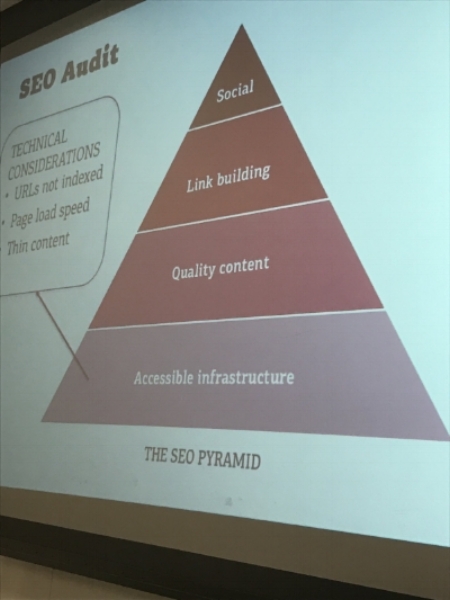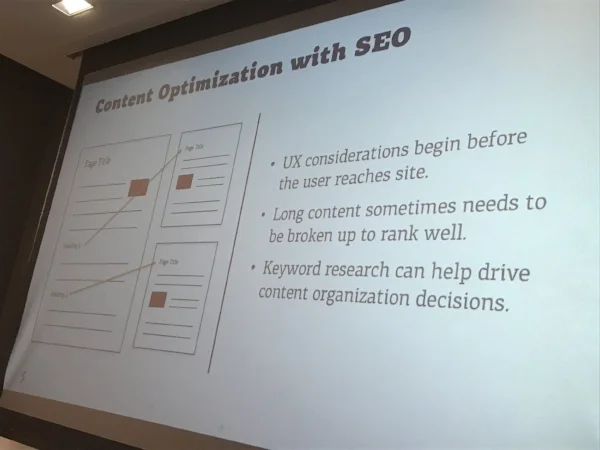Beyond Keywords: How UX Can Hurt SEO
On January 14, 2017, I attended UX Camp DC. While I was disappointed in the lack of content strategy topics on the board (it's a BarCamp format), there was a talk that was all about content strategy. UX in an SEO World, presented by Lindsay Burack and Erin Golden, information architects from Sapient Government Services, gave us a good look into how design decisions can affect SEO.
For the better part of the history of the web, we've left SEO up to marketers. From day one, it was about keywords and having more of the right ones on any given page. Once Google took over the search engine market, they started changing things fast. And they continue to change constantly. Today, as it's been for many years, quality content that matches a searcher's inquiry is what the search engine will deliver in the results. Keyword tag stuffing went out the window many years ago.
More recently, SEO has become a much more technical and strategic field. Search Engine Land's Periodic Table Of SEO Success Factors divides SEO factors into "On-the-Page Factors" and "Off-the-Page Factors." The On-the-Page Factors are the things you can control, whether it's in the content on the page or the underlying code. Meanwhile, Off-the-Page Factors are things you cannot control, the signals others give that help Google recognize your site or page as the best for a particular query.
Today, SEO needs to be part of everyone's job: content strategists, marketers, designers, developers. Lindsay and Erin did an excellent job of explaining how some things that we've been doing on our websites in the name of user experience are hurting the chances of people finding the website or web pages. Here are some takeaways from this talk.
Experiences don't start on your site
If you think that SEO doesn't matter, think again! More and more experiences are starting on Google. We now have to think of Google as a (creepy) persona. Google has become so sophisticated with its results pages that someone may get an answer from your content without ever going to your website! This means you not only need to rank well, but you need to have your content structured in a way that it shows up in the right places to get your content to your audience. Your content is valuable whether people get it from your website or another place. Make it possible for them to get it wherever they can.
If your site is not being found, the best experience in the world doesn't matter. Get your site in shape by making sure the infrastructure is set up properly. This includes technical considerations like
- URLs being indexed and crawlable, and make sure they contain meaningful keywords
- Fast page load
- HTML tags that are structured properly, especially the title tag and headers
Accessible infrastructure is the base of the SEO Audit pyramid
Beware of thin content
You know those "gateway pages" that collect a bunch of bits of content from other parts of the site? The ones that contain no original content and provide no context for search engines? Those are considered "thin content," or low-quality content. Google penalizes sites for thin content.
This is part of the "Panda penalty." The Google Panda algorithm was rolled out several years ago and placed more emphasis than ever on quality content. Unlike previous algorithms, Panda penalizes your entire domain when even just one bad page exists.
Optimize your content
While the user experience on your site might be perfectly fine, the set up might be hurting SEO. Remember, people have to find your site for it to be useful to them. So you've got to make sure your content is optimized for it to be found – and also usable and readable for the humans who want it.
Consider breaking up long pages for better ranking.
Lindsay and Erin used the Mammograms page on Cancer.gov as an example. This page was tested with users for readability and usability, and it performed well. It's clearly laid out with typical questions people have about mammograms. It uses plain language. All the things a person needs is on this page. That's all wonderful, right?
Google may think otherwise. Let's say "what is a mammogram?" is a top search phrase. You might think that because this is clearly on this page that it would rank pretty high on Google. Not necessarily. Because there are so many other bits of information on this page, Google might not get the right signal that this is the best page to return in its search results for that query. With long content like this, it might be helpful to break it up into a few pages with less, more focused information on each page.
Bake SEO into your content
SEO needs to be given equal importance as other areas when creating your website. If you wait until you're writing to address some keyword research findings after the site is many months or years old, you'll have a lot of work to do. You'll have to combat penalties, make up for declining traffic, and do a lot of re-architecting of both code and content.
Focus on SEO, get everyone on board with metadata, and change your writing and content development process to ensure you can be found in search engines.
Instead, you want to bake SEO into your content development process. Some ways to do this are:
- Think about topics, not formats or departments. This creates the content verticals that Google rewards. It also helps your readers. Win-win!
- Create editorial calendars in which content, social, and SEO intersect.
- Educate writers on use of metadata and keywords when creating content.
What about the keywords?
Of course, finding the right keywords is essential. But it should be clear now that they are only one piece of the search engine optimization puzzle. There are people who specialize in keyword research and analyzing rankings and results. To be sure, there is a lot of fine tuning to be done constantly. It's a harsh, ever-changing world out there. But that does not excuse you, whether you're a designer, developer, or communications manager, from making sure your website is making proper use of those keywords.
Every content or information architecture project Tanzen does includes baseline SEO techniques. SEO is not someone else's job. It's our job. It's your job. Want to make sure your team includes SEO in everything it does? Our Digital Writing Workshop includes an entire section on Writing for SEO, along with all the other things that bake SEO into your web writing.




